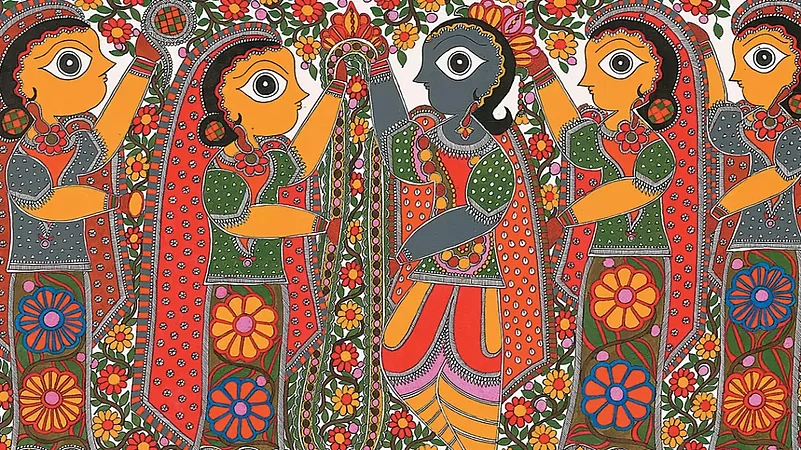“Sita had a sister?” This is the most instinctive response prompted by most if not many. Yes, Sita had a sister Urmila, and two cousins—Mandavi and Shrutakirti, the two daughters of King Janak’s brother.
While the Ramayana provides an in-depth and multi-layered exploration of brotherly love, it is through Sita’s sisters that we get a glimpse of a nuanced undercurrent of the theme of sisterhood and women’s solidarity.
The Ramayana is often seen as an exposition on ideal brotherhood where the inherent affection among brothers, and respect and regard for the elder siblings are never totally sacrificed for selfishness, power or greed—the theme runs across through four sets of brothers—Rama and his three brothers, Vali and Sugriv, Jatayu and Sampati, and finally Ravan and his two brothers, Kumbhakarna and Vibhishan.
Against this grand symbolism of brotherhood are interspersed stories of women and the subtle stream of sisterhood, mostly relegated to be buried under the massive heft of the larger themes in the Ramayana. Sita’s sisters struggle for cognisance as they refashion the narrative to reveal a series of stories of women—and these four siblings in particular.
Lest we forget, the Ramayana is a story not essentially of Lord Ram and heroism, but also of Sita. It is through Sita that we enter a brave world of remarkable women—some gritty, some gracious, and some maleficent. Most women are minor characters but they play a significant role. Through each one of them in their relationship with Sita are told stories of sisterhood.
It starts with Sita and her sisters—Urmila, and her two cousins Mandavi and Shrutakirti—all brought up together in the lap of love and luxury, but more importantly, under the tutelage of a sagacious man called King Janak, a raj-rishi, and a philosopher-king, who would hold annual philosophical conferences in his court. It is in such a world full of scholars and intellectuals who would indulge in debates and reasoning that the four girls are brought up in Mithila. They are sisters by blood, Sita being an adopted child notwithstanding, and their sisterhood holds a certain significance as these four girls later get married to the four princes of Ayodhya.
The four weddings bring them closer while immediately altering their equation—from little girls into little wives, from sisters, they become sisters-in-law as well. But like the four brothers, this sisterly love, too, is unique.
As Sita and her sisters move from the palace of Videha to Ayodhya, they start a new life by embarking on a new journey and get to experience different situations. However, meeting a range of new people, most importantly different women, helps form the stories in Sita’s narrative of self-discovery. As Sita meets one woman after another—the ‘minor’ women characters of the Ramayana—she questions her own situation, her identity and the complexities of the idea of love and loyalty, duty and doubts.
Both Kaushalya and Sumitra, the two queen-mothers, caution their daughters-in-law on the life and responsibilities they have taken on—a glimpse of the very feminine camaraderie between women. Their voices, speaking to one another, powerfully reinforce a spirit of sisterhood that contrasts with the Ramayana of rivalry and revenge. Kaikeyi stays in the background, only to reemerge later. She picks up the threads in her stark and infamous vamp mood.
As Sita is hurtled from a life of serenity in her home in Videha to the societal restraints and political intrigues of the palace in Ayodhya, she finds solace in and support from her sisters, who are all facing the same situation. They provide silent but strong support to each other and give each other the strength to survive in their new restrained, golden world, so vastly different from the land of freedom and expression they came from.
It is Urmila whom she is closest to and their relationship is a parallel of the other ‘perfect’ sibling love—that of Ram and Lakshman. To make matters more complicated, Urmila is also the wife of Lakshman, and her story is the story of a woman torn between two people whom she cherishes the most—Sita and Lakshman. She does not have the luxury to get to choose; instead, she takes a step back to give her silent but strong support to each of them. Yet she is the only one who fights for justice for her sister when Sita is banished from Ayodhya.
If Ram and Sita stand as the perfect couple personifying love and solidarity, Urmila and Lakshman take it to a more meaningful, realistic level. Like her cousins, theirs too is not a love story but a story of separation and patience; trust and waiting. And they overcome all to love and live happily ever after, unlike Ram and Sita.
Urmila, the wise daughter of King Janak, was a scholar and an artist. There is a folk story of how she wallows in pain and grief and undertakes a mammoth project of painting the wedding of the four sisters to the four princes of Kosala for all those fourteen years. The original story is that she chose to remain asleep for fourteen years and lent her waking hours to Lakshman so that he could guard his brother and his sister-in-law all through the exile.
As the four princesses gradually get enmeshed in royal intrigue, power and politics, the bond between them does not disintegrate; it gets stronger. As Sita leaves for the forest to join Ram in his exile, thus begins the private fourteen-year exile for each of the sisters as well.
Urmila awaits Lakshman’s return, Mandavi remains in the palace of Ayodhya as her husband Bharat resides in a hut in Nandigram, anticipating Ram’s return to the throne. Shrutakirti stays in the royal palace, living a life of celibacy like her husband Shatrughan. Though these sacrifices are mentioned in passing, but they delicately depict the evolving nature of the sisters’ relationship as they grow and mature.
It is Urmila who uses her skills of persuasion and eloquence to reprimand her husband Lakshman and even Ram, and cautions them while lending dignity to the grief and separation the sisters are forced to suffer. While Mandavi and Shrutakirti recede further into the background as the story progresses, their presence is felt through the turmoil that threatens to rip the family apart.
While Urmila displays patience and fortitude, Mandavi has the perseverance and her younger sister has the foresight of what might take place in the palace in the absence of the old king, the lingering absence of Ram, Sita and Lakshman and in the presence of three widowed queen-mothers. These are the three girls who hold the fort till the three return from exile.
The sisters share a strange but strong connect of similar conditions, experiences and concerns, unaffected by the materialism and corruption that define women’s characters and lives otherwise. Though they remain in the shadows, they throw light on the life they share with Sita as the princess-brides of the four princes of Ayodhya. They are each other’s saviours in their worst moments of tears and tragedy and over time, by overcoming the tribulations, the sisters are Sita’s sole confidants, friends and companions.
Theirs is the only close relationship that is strong enough to brave the storm by sticking together through their adversities. They are mature enough to offer words of solace and wisdom, they are resolute in their unity, and do not allow jealousy and resentment to corrupt their love.
In each of these associations and interactions, Sita forges a sisterhood with other women; their solidarity is an imperceptible link, a journey of her self-discovery from self-effacement to selfhood, of a certain emancipation and rebellion of different kinds. It is not merely a connection, it is an interlinking, developed with love and support, patience and interest and reciprocity.
The epic subtly urges the need to initiate conversations around the bond of sisterhood between women just as we glorify brotherhood between men. It should be a strong, recurring notion and experience around us. This close bond between the sisters and other women characters is a case in point that women are not women’s enemies—a convenient narrative cultivated through centuries and cultures. Women can coexist peacefully. Though layered, the epic reveals this argument for sisterhood and solidarity that has never been observed, unfortunately.
That deep, selfless sisterly love which Urmila, Mandavi and Shrutakirti symbolise is, of course, tested during troubled times and family conflicts. Even though the sisters become sisters-in-law, they refuse to get alienated in the throes of trials and tragedy and remain friends. They become each other’s shields and armours, besides being spontaneous counsellors till all is reconciled.
In other words, perhaps the different shades of sisterhood in the Ramayana remind us of the different dimensions of solidarity, unanimity and harmony that can exist among women; a loyalty, a connection greater than friendship, which is unconditional and forever...”
(Views expressed are personal)
(This appeared in the print as 'Sita’s Sisters')
Kavita Kane is a best-selling author who has brought in feminism in mythology





















